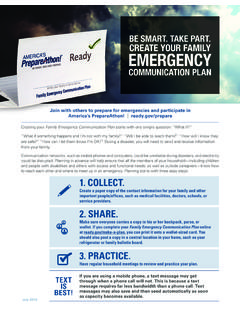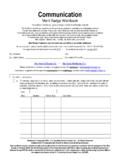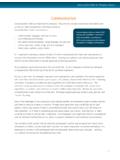Transcription of Communication Tower Best Practices
1 Communication Tower best PracticesOSHA 3877-06 2017 This document is advisory in nature and informational in content. It is not a standard or regulation, and it neither creates new legal obligations nor alters existing obligations created by OSHA standards or the occupational safety and health Act. Pursuant to the OSH Act, employers must comply with safety and health standards and regulations issued and enforced either by OSHA or by an OSHA-approved state plan. In addition, the Act s General Duty Clause, Section 5(a)(1), requires employers to provide their employees with a workplace free from recognized hazards likely to cause death or serious physical harm. Material contained in this publication is in the public domain and may be reproduced, fully or partially, without permission. Source credit is requested but not information will be made available to sensory-impaired individuals upon request.
2 Voice phone: (202) 693-1999; teletypewriter (TTY) number: 1-877-889-5627. Cover photo: Vertical LimitCommunication Tower best Department of LaborOccupational safety and health administration andThe Federal Communications CommissionOSHA 3877-06 2017 best Practices in Communication Tower safety , gathered from industry stakeholders and participants in the DOL/FCC Joint Workshops on Tower Climber safety on October 14, 2014 and February 11, of ContentsIntroduction and Background ..1 General Topics ..3 Tower Climbers and Ground Crew Employees ..6 Carriers and Tower Owners ..7 Tur fing Ve nd or s ..14 Tower Construction and Maintenance Contractors ..16 For More Information .. 22 FEDERAL COMMUNICATIONS COMMISSION1 Introduction and BackgroundThe occupational safety and health administration and the Federal Communications Commission are concerned about the risks faced by employees in the Communication Tower industry.
3 Employees climb Communication towers to perform construction and maintenance activities and face numerous hazards, including fall hazards, hazards associated with structural collapses and improper rigging and hoisting Practices , and struck-by hazards. The business structure of the Communication Tower industry presents additional challenges to ensuring employee safety . When carriers own their own towers and directly employ the employees who build and maintain the towers and the equipment on them, the carriers have the ability and incentive to ensure safe Practices . Typically, however, the relationship between carriers and Tower employees is more complicated. For example: towers are often owned by separate corporations (not carriers, generally), and are built by contractors; Carriers often contract with turfing vendors for the installation and maintenance of equipment on towers ; Turfing vendors, in turn, may hire other contractors to perform work; and These contractors may sub-contract Tower work to still smaller employers.
4 As a result, carriers and Tower owners may not know who is performing work for them, or when work is being performed. Thus, responsibility for employee safety is fractured into many layers. Instead of a single company having control and responsibility for employee safety and Tower occupational safety AND health ADMINISTRATION2integrity, employer responsibilities can be spread over numerous small employers. Additionally, the amount of Communication Tower work being performed waxes and wanes with waves of new technology. The work is physically demanding and requires employees to spend long periods of time away from home; hence, job tenure tends to be short and turnover tends to be high. In light of these circumstances, ensuring employee safety requires accountability and diligence throughout the contracting process, all the way from the carrier to the individual employee performing the work.
5 Recognizing the risks that Tower employees face, OSHA and the FCC held a workshop on Communication Tower employee safety on October 14, 2014. During this workshop, industry stakeholders, along with employee safety advocates and the families of Communication Tower employees who had been killed on the job, gathered to discuss issues affecting the safety of Communication Tower employees. A follow-up workshop was held on February 11, 2016, during which a panel of industry stakeholders and advocates discussed best Practices that could reduce injuries and fatalities among Tower document is a collection of the best Practices gathered from those workshops and from the discussions that continued beyond those events. These best Practices are focused on the ways in which each level in the contracting chain can build a positive culture of safety and accountability.
6 This cultural change is a critical first step in creating a safer environment for all employees in the industry. Some industry stakeholders have already begun to take major steps towards instituting this shift in policies, Practices , and attitudes, and OSHA and the FCC are committed to supporting these COMMUNICATIONS COMMISSION3 General TopicsSafety and health programsAll entities should establish a comprehensive safety and health program. This program should address all of the hazards associated with Communication Tower work, and all companies should ensure that their safety and health programs are compatible with the safety requirements imposed by other companies in the contract core elements of a comprehensive safety and health program include1: Management leadership: Managers at all levels continually demonstrate their commitment to improved safety and health .
7 Accountability and diligence is maintained at every level of the organization. Employee participation: Employees are involved in all aspects of the program and understand their roles and responsibilities under the program and what they need to do to carry them out effectively. Hazard identification and assessment: Procedures are put in place to continually identify workplace hazards and evaluate risks, both job-specific and systemic. Hazard prevention and control: A plan is developed to ensure that hazard controls are implemented, to track progress, and to verify the effectiveness of controls once they are implemented. Education and training: All supervisors and employees are trained to understand how the program works and how to carry out the responsibilities assigned to them under the For more information on safety and health programs, see OSHA s Recommended Practices for safety and health Programs at safety AND health ADMINISTRATION4 Program evaluation and improvement: Processes are established to monitor program performance, to verify program implementation, to identify program deficiencies and opportunities for improvement, and to take actions necessary to improve the program and overall safety and health performance.
8 Communication on multiemployer workplaces: Host and contract employers coordinate on work planning and scheduling to identify and resolve any conflicts that could impact safety or health . safety and health programs and contracting Practices To maximize effectiveness, coordination of safety and health programs along the contracting chain should be managed by a designated person (for example, a Chief safety Officer) to ensure clear lines of responsibility and accountability. This designated person will ideally have some personal experience climbing and working on towers or have a close advisor who has such experience. The program should clearly delineate the roles and responsibilities of each party in the contracting chain in regards to employee safety and health . Abiding by these roles and responsibilities should be a condition of awarding contracts.
9 The safety and health program should establish concrete consequences for contractors that do not take appropriate steps to ensure the safety of their employees. In some instances, termination of the contract may be an appropriate COMMUNICATIONS COMMISSION5 All lower-tiered contractors should be required to have written safety and health programs of their own. It is strongly recommended that contractor safety and health programs be reviewed on at least an annual basis to ensure that they are functioning as designed and to identify areas for improvement. Verification of subcontractorsEvery entity in the contract chain should require lower-level contractors to have comprehensive safety and health programs in place that identify a Chief safety Officer, and written verification procedures that can be adopted to ensure that contractors are implementing such programs.
10 The verification process should include: Clear criteria for vetting and approving all contractors (including subcontractors), and verification that all contractors are subject to the same vetting criteria; Procedures for obtaining (or requiring contractors to maintain) certification and training records for each climber on site; Procedures for obtaining written approval for any subcontracting; Procedures providing for the ongoing monitoring and evaluation of contractor safety records (including OSHA records); Criteria for considering a contractor s safety record in the awarding of future contracts; and Provisions for independent (third-party) audits of job sites to ensure that the contractors performing work are vetted contractors and that they are performing work using appropriate safety safety AND health ADMINISTRATION6 Stop work authority: safety and health programs should authorize and instruct all employees, at all levels in the contracting chain, to stop work on a project if unsafe conditions are discovered and provide assurance to those employees that there will be no repercussions or reprisals for doing so.














